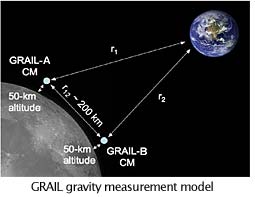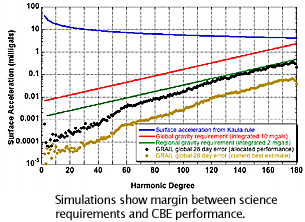
The Gravity Recovery And Interior
Laboratory (GRAIL) will unlock the mysteries of the Moon. By mapping the lunar
gravitational field globally not just on the nearside to
unprecedented accuracy and resolution, GRAIL will, in essence, peer deep
inside the Moon (see right) to reveal its internal structure and thermal
history.
Knowledge acquired about the Moon from GRAIL will be extended to
understand the broader evolutionary histories of the other rocky planets
in the inner solar system: Earth, Venus, Mars, and Mercury. Indeed, the Moon
is a lynchpin for understanding how the terrestrial planets evolved.
GRAIL is the lunar analog of the very successful Gravity Recovery and Climate
Experiment (GRACE) twin-spacecraft terrestrial gravity recovery mission that
was launched in 2002 and continues to operate. GRAIL will be implemented
with a science payload simplified from GRACE and a spacecraft derived from
the Lockheed Martin Experimental Small Satellite-11 (XSS-11) launched in
2005.

GRAIL will place two spacecraft
(represented as GRAIL-A and GRAIL-B to the left) in a low-altitude (50 km),
near-circular, polar lunar orbit to perform high-precision range-rate measurements
between them using a Ka-band payload. Subsequent data analysis of the spacecraft-to-spacecraft
range-rate data provides a direct measure of the lunar gravity.
The payload, flight system and mission design ensure that all error sources
that perturb the gravity measurements are contained at levels well below
those necessary to meet science requirements. The figure below illustrates
performance margin between the science requirements (red and green), the
allocated performance (black), and Current Best Estimate (CBE) performance
(gold). These margins enable GRAIL's low-risk implementation.
 GRAIL's short mission duration
(270-days) includes a 90-day gravity mapping Science Phase. Initial science
products will be available beginning 30 days after the start of the Science
Phase and will be delivered to PDS no later than 3 months after the end of
the Science Phase.
GRAIL's short mission duration
(270-days) includes a 90-day gravity mapping Science Phase. Initial science
products will be available beginning 30 days after the start of the Science
Phase and will be delivered to PDS no later than 3 months after the end of
the Science Phase.
Included on the spacecraft is an "E/PO MoonKam" assembly that
provides images and video of the lunar surface as part of the E/PO and Student
Collaboration segment of GRAIL.